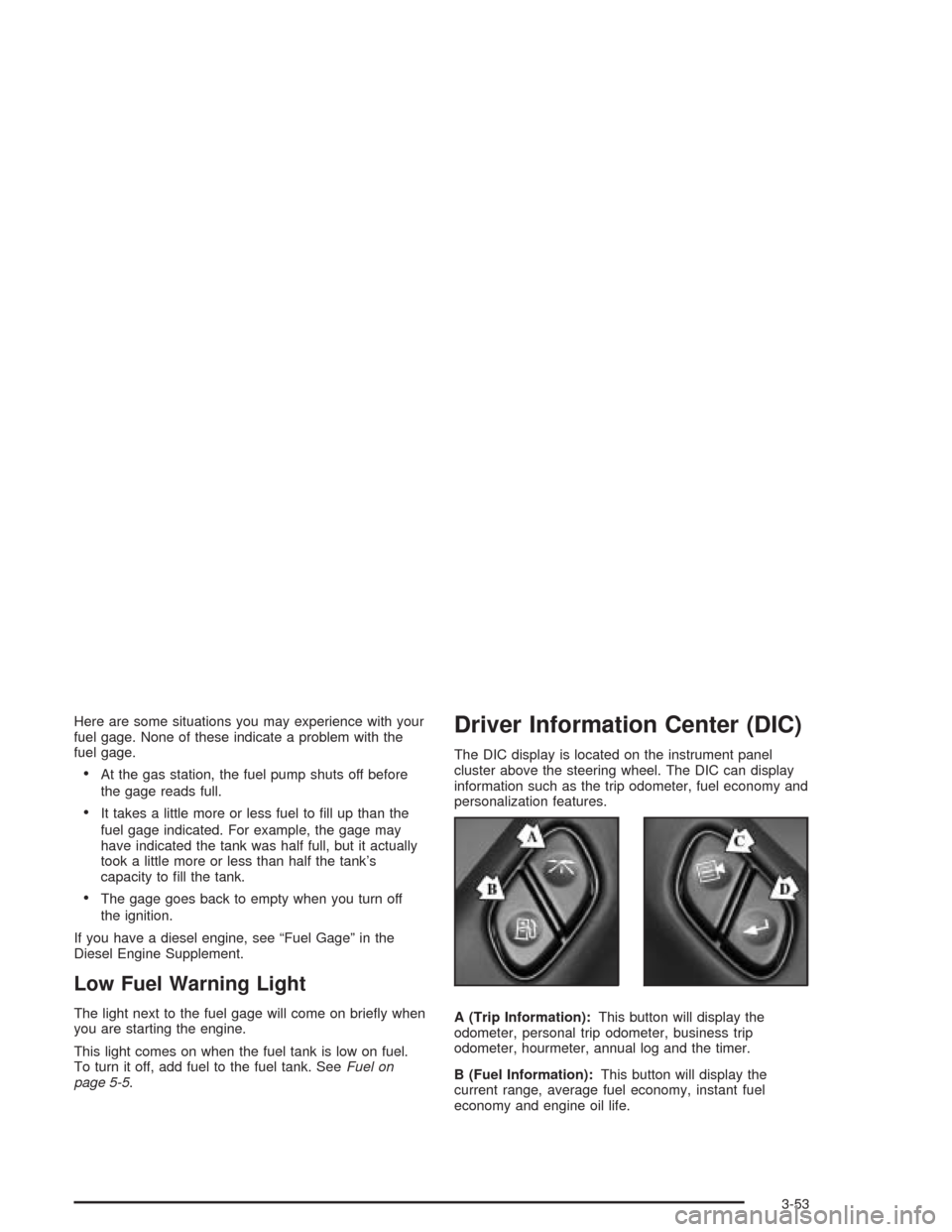Page 217 of 584

Here are some situations you may experience with your
fuel gage. None of these indicate a problem with the
fuel gage.
At the gas station, the fuel pump shuts off before
the gage reads full.
It takes a little more or less fuel to �ll up than the
fuel gage indicated. For example, the gage may
have indicated the tank was half full, but it actually
took a little more or less than half the tank’s
capacity to �ll the tank.
The gage goes back to empty when you turn off
the ignition.
If you have a diesel engine, see “Fuel Gage” in the
Diesel Engine Supplement.
Low Fuel Warning Light
The light next to the fuel gage will come on brie�y when
you are starting the engine.
This light comes on when the fuel tank is low on fuel.
To turn it off, add fuel to the fuel tank. SeeFuel on
page 5-5.
Driver Information Center (DIC)
The DIC display is located on the instrument panel
cluster above the steering wheel. The DIC can display
information such as the trip odometer, fuel economy and
personalization features.
A (Trip Information):This button will display the
odometer, personal trip odometer, business trip
odometer, hourmeter, annual log and the timer.
B (Fuel Information):This button will display the
current range, average fuel economy, instant fuel
economy and engine oil life.
3-53
Page 417 of 584
When to Add Engine Oil
If the oil is at or below the cross-hatched area at the tip
of the dipstick, then you will need to add at least one
quart of oil. But you must use the right kind. This section
explains what kind of oil to use. For engine oil
crankcase capacity, seeCapacities and Speci�cations
on page 5-132.
Notice:Do not add too much oil. If your engine has
so much oil that the oil level gets above the
cross-hatched area that shows the proper operating
range, your engine could be damaged.SeeEngine Compartment
Overview on page 5-14for
the location of the
engine oil �ll cap.
Be sure to add enough oil to put the level somewhere in
the proper operating range. Push the dipstick all the
way back in when you are through.
5-21
Page 548 of 584
Normal Maintenance Replacement Parts
Replacement parts identi�ed below by name, part number, or speci�cation can be obtained from your dealer.
VIN Code W V T
Oil Filter 25010792**/PF47* 25010633**/PF44* 25010633**/PF44*
Engine Air Cleaner/Filter 25313348**/A1519C*† 25313348**/A1519C*† 25313348**/A1519C*†
PCV Valve 6487532**/CV769C* — —
Spark Plugs25162556**
/41–932*12571164**
41–985*12571164**
/41–985*
Wiper Blades 15153642** 15153642** 15153642**
Wiper Blade Type ITTA ITTA ITTA
Wiper Blade Length22 inches
(56.0 cm)22 inches
(56.0 cm)22 inches
(56.0 cm)
*ACDelco
®part number
** GM part number
†A1518C high-capacity air cleaner �lter may be substituted.
6-16
Page 549 of 584
VIN Code U N G
Oil Filter 25010633**/PF44* 25010633**/PF44* 89028862**/PF454*
Engine Air Cleaner
/Filter25313349**
A1518C*25313349**
A1518C*25313349**
A1518C*
PCV Valve — — —
Spark Plugs 12571164**/41–985* 12571164**/41–985* 12578277**/41–983*
Wiper Blades 15153642** 15153642** 15153642**
Wiper Blade Type ITTA ITTA ITTA
Wiper Blade Length22 inches
(56.0 cm)22 inches
(56.0 cm)22 inches
(56.0 cm)
*ACDelco
®part number
** GM part number
†A1518C high-capacity air cleaner �lter may be substituted.
6-17